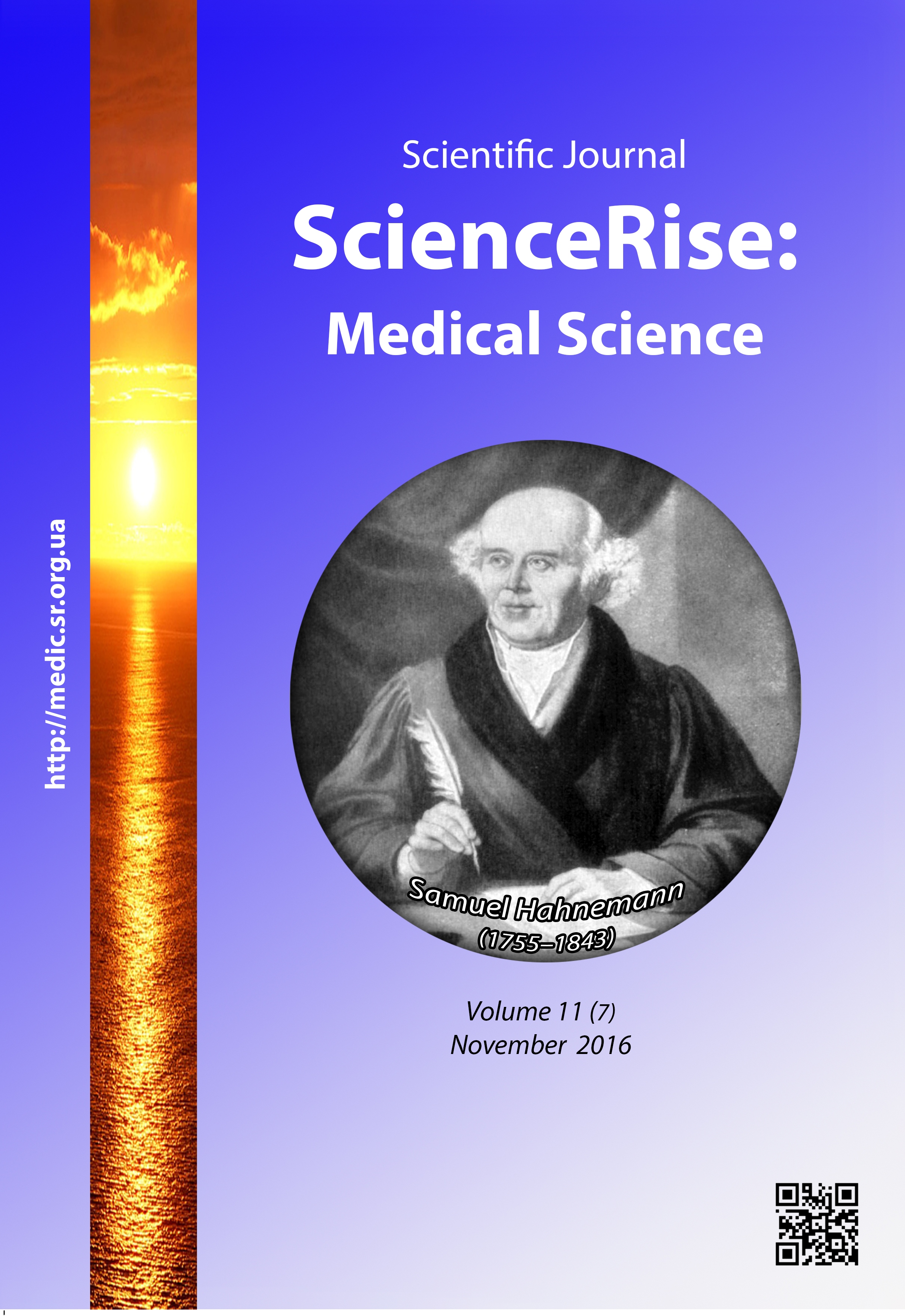The changes in amino acids composition of the blood associated with reproductive losses and their correction
DOI:
https://doi.org/10.15587/2519-4798.2016.84312Keywords:
reproductive losses, heterochromatin, folate cycle, amino acids, biochemical study of blood, prophylaxisAbstract
The results of examination of women with reproductive losses (RL) in anamnesis, realized within medical-genetic consultation for explanation of the role of changes of heterochromatin (chromosome polymorphism) and the features of folate metabolism in women with RL with the perspective of individualization of preconception support on the base of determination of character of causal relation between these phenomena, were presented in the article.
Aim of research: specification of the role of chromosome polymorphism and changes of amino acid composition of blood in women as the possible markers of high risk of RL.
Material and methods: two groups of women were examined: I - 154 observations with obstetric anamnesis, complicated with RL and II - 32 practically healthy women with non-complicated reproductive anamnesis, who underwent preconception prophylaxis before planning of pregnancy. The genealogical anamnesis, features of the state of internal organs, genitals were studied. The special studies included cytogenetic analysis, determination of the level of free sulfur-containing amino acids (methionine, cystine, cysteine, taurine) by the method of highly effective liquid chromatography.
Results: The frequency of structural changes of chromosomes in women with RL is 36,4 %. The types of slight chromosome anomalies in 3,9 % was the carriage of extremal variants of C-polymorphism; in 18,8 % – polymorphism of adjacent districts of chromosomes 13, 14, 15, 17, 21, 22; in 1,9 % – increased size of сentromere heterochromatin in chromosome; in isolated cases – the increase of linear sizes of heterochromatin districts of 9 chromosome and combination of polymorphism of adjacent districts of 15 chromosomes. In 7,1 % of cases polymorphism of adjacent districts of 21 chromosome was detected. The statistical connection between the carriage of chromosome and gene polymorphism in women with RL in anamnesis was detected. The significant difference between the main and control groups was detected only for methionine among sulfur-containing amino acids. Hyperhomocysteinemia was detected in 71,9 % of women of the main group.
Conclusions: Preventive strategy as to reproductive losses must provide the timely diagnostics and correction of disorders of folate cycle that is determinative component of personalized primary prophylaxis of the disorder of reproductive function of family in the modern Ukrainian populationReferences
- Radzinsky, V. E., Dimitrov, V. I., Myskova, I. Y. (2009). Non-developing pregnancy. Moscow: GEOTAR-Media, 200.
- Sukhikh, G. T., Vanko, L. V. (2012). Immune factors in the etiology and pathogenesis of complications of pregnancy. Obstetrics and gynecology, 1, 128–136.
- Guss, K. A., Nelson, C. E., Hudson, A., Kraus, M. E., Carroll, S. B. (2001). Control of a Genetic Regulatory Network by a Selector Gene. Science, 292 (5519), 1164–1167. doi: 10.1126/science.1058312
- Arbuzov, S. B., Averianov, A. I., Krasnov, V. V., Glazkova, І. V., Burjachenko, O. І. (2012). Diagnosis of congenital heart disease in conditions beswick genetic screening. Archive klynichnoyi and Experimental Medicine, 21 (2), 126–128.
- Grechanina, E. Ya., Grechanina, Yu., Gussar, V. A. (2008). Phenotypes associated with polymorphic genes of folate cycle, as a manifestation of epigenetic modifications of the genome. Mat. IV Congress of medical geneticists of Ukraine with international participation. Lviv, 39–40.
- Kalashnikov, E. A., Kokarovtseva, S. N. (2006). Association of hereditary factors of thrombophilia with pregnancy loss in women in the Russian population. Mathematica, 8, 386–391.
- Lebedev, I. N. (2008). Epigenetic modifications of the genome in the embryonic period of human ontogenesis. Novosibirsk, 40.
- Ashfield-Watt, P. A., Pullin, C. H., Whiting, J. M., Clark, Z. E., Moat, S. J., Newcombe, R. G., Burr, M. L. et. al. (2006). Methylenetetrahydrofolate reductase 677C→T genotype modulates homocysteine responses to a folate-rich diet or a low-dose folic acid supplement: a randomized controlled trial. The American Journal of Clinical Nutrition, 76, 180–186.
- Surani, M. A. (2001). Reprogramming of genome function through epigenetic inheritance. Nature, 414 (6859), 122–128. doi: 10.1038/35102186
- Shmelev, V. M., Papayan, L. P., Saltykov, N. B., Kargin V. D. (2010). Clinical and laboratory diagnosis and treatment of thrombophilia due to hyperhomocysteinemia. Saint Petersburg:"SPB MAPO", 34.
Downloads
Published
How to Cite
Issue
Section
License
Copyright (c) 2016 Тарана Джафар кизи Алієва

This work is licensed under a Creative Commons Attribution 4.0 International License.
Our journal abides by the Creative Commons CC BY copyright rights and permissions for open access journals.
Authors, who are published in this journal, agree to the following conditions:
1. The authors reserve the right to authorship of the work and pass the first publication right of this work to the journal under the terms of a Creative Commons CC BY, which allows others to freely distribute the published research with the obligatory reference to the authors of the original work and the first publication of the work in this journal.
2. The authors have the right to conclude separate supplement agreements that relate to non-exclusive work distribution in the form in which it has been published by the journal (for example, to upload the work to the online storage of the journal or publish it as part of a monograph), provided that the reference to the first publication of the work in this journal is included.









